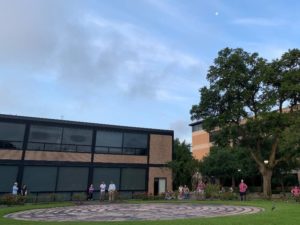Friday’s first e‑mail, the “Message of the Day,” began “Open to the New…”.
It closed with “See things with a beginner’s attitude of wonder.”
Those words buzzed in my head as I drove before sunrise to Rothko Chapel’s Summer Solstice observance.Two key differences this season:
1) Because the chapel is under renovation, the event moved to the Gueymard Meditation Garden at the University of St. Thomas, and
2) Because that garden includes a labyrinth, we—60 strong—walked the Chartres-based path together.
 Joining us before/during the observance were persistent Southwest Airlines jets and a receding full moon.
Joining us before/during the observance were persistent Southwest Airlines jets and a receding full moon.
Sweet and sour — both unexpected company.
But the noise and the vision reminded me: we’re all on a journey of some kind.
Every day. We’re either coming or going but j‑o-u-r-n-e-y-i-n‑g all the same. Am I too much the Pollyanna, suggesting we must all remember this?
The music of flutist Laura Lucas and guitarist John Edward Ross muted traffic passing by on West Alabama. All the color sang, too.
As only red roses and orange dresses can.
A trio of water fountains bubbled to life at eight a‑m.
 A blanket of comfort fluttered down: water’s best offering when it springs forth in such peaceful solace.
A blanket of comfort fluttered down: water’s best offering when it springs forth in such peaceful solace.
With a crowd this large, we bumped, turned, reversed, and paused our way along the four quadrants of the labyrinth.
Even so, we disappeared into our internal worlds as we traveled. No words spoken anywhere. None needed on this circular path.
Amid steady turns along the single-lane path, we progressed toward the labyrinth’s center point. There, we each paused, reflected, then headed back out to where we each had started.
Before we began, our walk facilitator, Jay Stailey, had suggested using the words release-receive-return as touchstones. One word for each phase of the three-part labyrinth journey.
The notion intrigued: that’s how we’ve been programmed to think of our lives. Three parts. Beginning-middle-end. I wonder: have I been using using the wrong words for 62 years?
Truth is, there’s no ‘wrong way’ to live — or labyrinth. How can there be when both still confuse so many?
Labyrinths exist globally, crossing cultures and centuries, religions and governments. They’ve survived because these pathways offer a universal place for meaning and healing.
Scholars such as Jean Houston consider the labyrinth a powerful tool for suspending left-brain activity (logic, analysis, structured thinking) in favor of tapping our right-brain gifts of intuition, creativity, and imagination.
 That concept roared in my ear after I finished my labyrinth walk.
That concept roared in my ear after I finished my labyrinth walk.
Heading to the car, I walked by the Chapel of St. Basil and a burst of sunlight beamed right onto my face.
With it came the words — “good walk, messages received, new season, better days.”
That green dot of light?
You tell me. It’s not a laser because no one was around. The labyrinth stands on the opposite side of this building. The campus is closed for the summer.
Woo-woo, indeed.
A solstice to remember.



